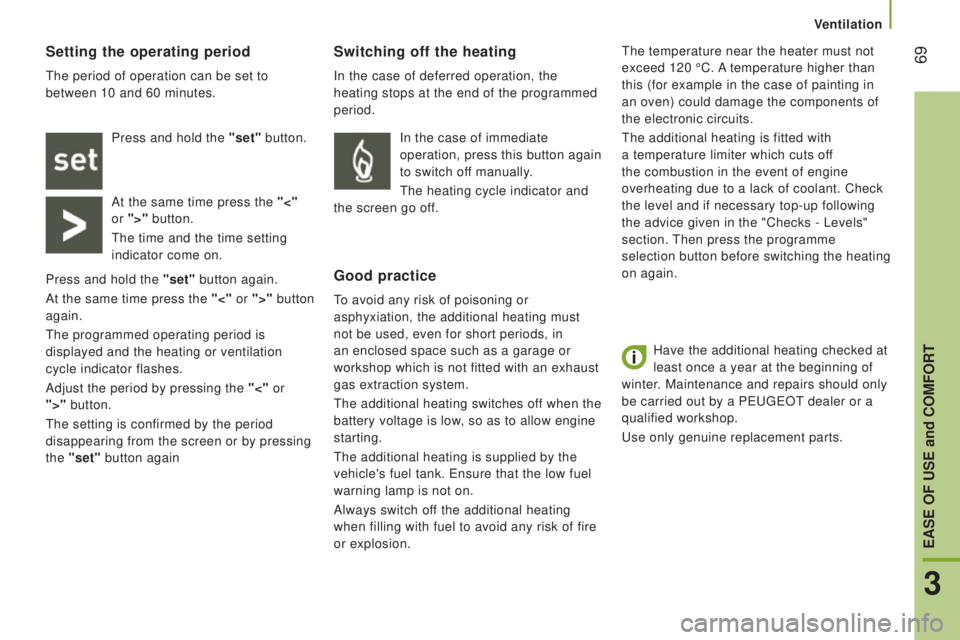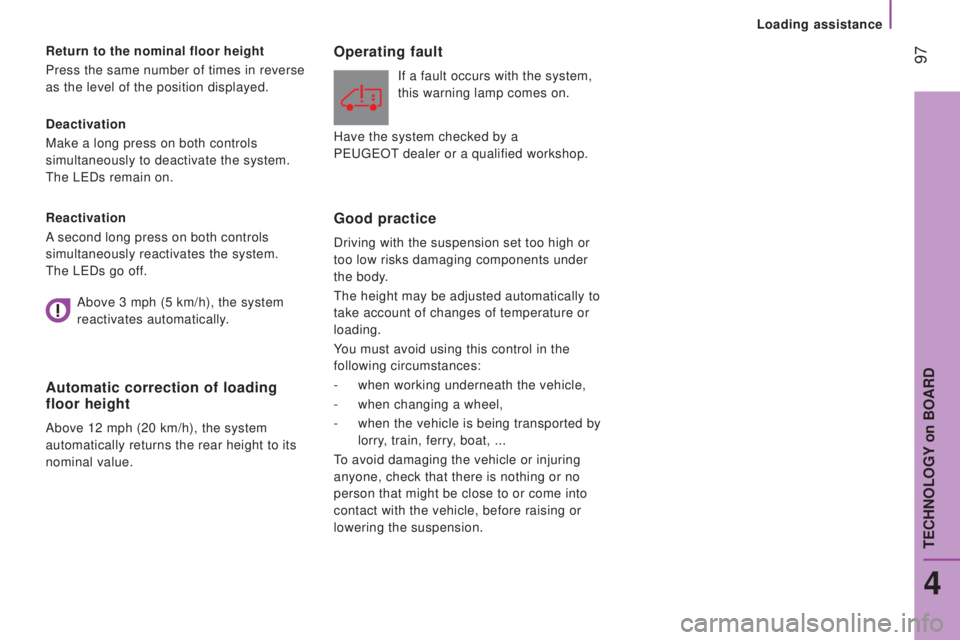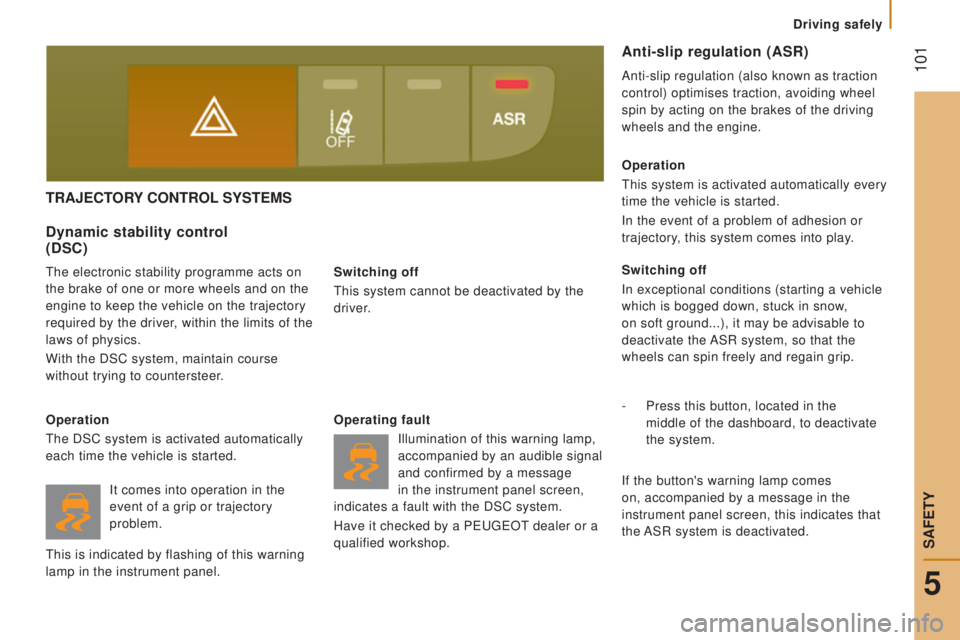2015 PEUGEOT BOXER warning
[x] Cancel search: warningPage 71 of 276

69
Have the additional heating checked at
least once a year at the beginning of
winter. Maintenance and repairs should only
be carried out by a P
eugeOt dealer or a
qualified workshop.
use only genuine replacement parts.
Switching off the heating
In the case of deferred operation, the
heating stops at the end of the programmed
period.
Good practice
to avoid any risk of poisoning or
asphyxiation, the additional heating must
not be used, even for short periods, in
an enclosed space such as a garage or
workshop which is not fitted with an exhaust
gas extraction system.
the additional heating switches of
f when the
battery voltage is low, so as to allow engine
starting.
the additional heating is supplied by the
vehicle's fuel tank.
ensure that the low fuel
warning lamp is not on.
Always switch off the additional heating
when filling with fuel to avoid any risk of fire
or explosion.
the temperature near the heater must not
exceed 120
°C.
A temperature higher than
this (for example in the case of painting in
an oven) could damage the components of
the electronic circuits.
the additional heating is fitted with
a temperature limiter which cuts off
the combustion in the event of engine
overheating due to a lack of coolant. Check
the level and if necessary top-up following
the advice given in the "Checks - Levels"
section.
then press the programme
selection button before switching the heating
on again.
Setting the operating period
the period of operation can be set to
between 10 and 60 minutes.
Press and hold the "set"
button.
At the same time press the "<"
or ">" button.
the time and the time setting
indicator come on.
Press and hold the "set" button again.
At the same time press the "<" or ">" button
again.
the programmed operating period is
displayed and the heating or ventilation
cycle indicator flashes.
Adjust the period by pressing the "<" or
">" button.
the setting is confirmed by the period
disappearing from the screen or by pressing
the "set" button again In the case of immediate
operation, press this button again
to switch off manually.
the heating cycle indicator and
the screen go off.
3
EASE oF uSE and coMFort
Ventilation
Page 91 of 276

89Menu…Press... Sub-menu… Press... Select…confirm
and exit Enables you to...
7
Measurement
unit (
unit)
Distance Km
Select the distance display unit.
Miles
Fuel
consumption km/l
Select the fuel consumption
display unit.
l/100 km
temperature °C
Select the temperature display
unit.
°F
8 Languages List
of languages
available Select the display language.
9
Volume of
announcements
(Buzz)Increase Increase/decrease the volume
of the announcements or of the
audible warning.
Decrease
10
Daytime
running lampsON Activate/deactivate daytime
running lamps.
OFF
11 Service Service (Miles/km
before service)
Display the miles/kilometres
remaining before the next
service.
Oil (Miles/Km
before oil change) Display the miles/kilometres to
the next oil change.
12
Passenger
airbag
(BA
g P) ON
Ye
s Activate the passenger airbag.
No
OFF Ye s
Deactivate the passenger
airbag.
No
13
e
xit from
menu
exit from the menu. Press the
arrow at the bottom to go to the
first menu.
4
teCHNOLOgY on BOARD
Vehicle configuration
Page 96 of 276

94
AudIBLE rEAr PArKInG SEnSorS
If fitted on your vehicle, the system consists
of four proximity sensors, installed in the
rear bumper.
they detect any obstacle: person, vehicle,
tree, fence, behind the vehicle during the
manoeuvre.
However, objects the size or thickness of
which are detected at the beginning of the
manoeuvre will no longer be detected at the
end of the manoeuvre: blind spots between
and below the sensors.
examples: stake,
roadworks cone or pavement post.
the rear parking sensor system may be
coupled with a reversing camera.operation
engage reverse gear with the gear lever.
the proximity information is indicated by an
audible signal of increasing frequency as the
vehicle approaches the obstacle.
When the distance between the rear of
the vehicle and the obstacle is less than
approximately thirty centimetres, the audible
signal becomes continuous.
Switching off
Come our of reverse gear into neutral.
operating fault
If this warning lamp comes
on in the instrument panel
accompanied by a message in
the screen, contact a P
eugeOt
dealer or a qualified workshop.
Good practice
the system cannot, in any circumstances,
replace the need for vigilance on the part of
the driver
.
take even greater care if you reverse with a
rear door open.
In bad weather or in winter
, ensure that the
sensors are not covered with mud, ice or
snow.
Parking sensors
Page 99 of 276

97
deactivation
Make a long press on both controls
simultaneously to deactivate the system.
the LeDs remain on.
return to the nominal floor height
Press the same number of times in reverse
as the level of the position displayed.
reactivation
A
second long press on both controls
simultaneously reactivates the system.
the LeDs go of
f.
Automatic correction of loading
floor height
Above 12 mph (20 km/h), the system
automatically returns the rear height to its
nominal value.
operating fault
If a fault occurs with the system,
this warning lamp comes on.
Good practice
Driving with the suspension set too high or
too low risks damaging components under
the body.
the height may be adjusted automatically to
take account of changes of temperature or
loading.
You must avoid using this control in the
following circumstances:
-
when working underneath the vehicle,
-
when changing a wheel,
-
when the vehicle is being transported by
lorry
, train, ferry, boat,
...
to avoid damaging the vehicle or injuring
anyone, check that there is nothing or no
person that might be close to or come into
contact with the vehicle, before raising or
lowering the suspension.
Above 3 mph (5 km/h), the system
reactivates automatically.
Have the system checked by a
P
eugeOt
dealer or a qualified workshop.
4
teCHNOLOgY on BOARD
Loading assistance
Page 100 of 276

98
PArKInG BrAKEHAzArd WArnInG LAMPS
Press this button, the direction indicators
flash.
they can operate with the ignition of
f.Applying
Pull the parking brake lever up to immobilise
your vehicle.
Check that the parking brake is applied
firmly before leaving the vehicle. Pull on the parking brake lever, only
with the vehicle stationary.
releasing
Pull the lever up slightly and press the
button to lower the parking brake lever.In the exceptional case of use of the
parking brake when the vehicle is
moving, apply the brake by pulling gently
to avoid locking the rear wheels (risk of
skidding).
If the parking brake is still on or has not
been released properly, this is indicated
by this warning lamp which comes on in
the instrument panel.
When parking on a slope, direct your wheels towards
the pavement and pull the parking brake lever up.
there is no advantage in engaging a gear after
parking the vehicle, particularly if the vehicle is loaded.
the hazard warning lamps should only
be used in dangerous situations, when
stopping in an emergency or when
driving in unusual conditions.
Driving safely
Page 102 of 276

100
Good practice
the
ABS system does not provide shorter
braking distances. On very slippery surfaces
(black ice, oil...) the ABS can extend braking
distances. For emergency braking, press the
brake pedal hard and do not release it, even
on a slipper surface; you will then be able to
steer the vehicle and avoid an obstacle.
When replacing wheels (tyres and
rims), ensure that they conform to the
manufacturer's recommendations.Emergency braking assistance
System which, in an emergency, enables
you to obtain the optimum braking pressure
more quickly, thus reducing the stopping
distance.
operation
It is triggered by the speed at which the
brake pedal is pressed.
the ef
fect of this is a reduction in the
resistance of the pedal and an increase in
braking efficiency.
Switching off
this system cannot be deactivated by the
driver.
operating fault
If this warning lamp comes on,
accompanied by an audible signal
and a message in the instrument
panel screen, it indicates a fault with
the anti-lock braking system which could result
in loss of control of the vehicle when braking.
For maximum braking efficiency, a
bedding-in period of around 300 miles
(500 kilometres) is needed. During this
period it is recommended that you avoid
harsh, repeated or prolonged braking. If this warning lamp comes on,
together with the ABS warning
lamp, accompanied by a message
in the instrument panel screen,
it indicates a fault with the electronic brake
force distribution which could result in loss
of control of the vehicle when braking. When braking in an emergency, press
firmly without releasing the pressure.
You must stop as soon as it is safe
to
do so.
In either case, contact a P
eugeOt dealer
or a qualified workshop.
Driving safely
Page 103 of 276

101
trAjEctorY controL SYStEMS
Switching off
this system cannot be deactivated by the
driver.
dynamic stability control
(dSc)
the electronic stability programme acts on
the brake of one or more wheels and on the
engine to keep the vehicle on the trajectory
required by the driver, within the limits of the
laws of physics.
With the DSC system, maintain course
without trying to countersteer.
operation
the DSC system is activated automatically
each time the vehicle is started.
operating fault
Illumination of this warning lamp,
accompanied by an audible signal
and confirmed by a message
in the instrument panel screen,
indicates a fault with the DSC system.
Have it checked by a P
eugeOt dealer or a
qualified workshop.
operation
this system is activated automatically every
time the vehicle is started.
In the event of a problem of adhesion or
trajectory, this system comes into play.
Switching off
In exceptional conditions (starting a vehicle
which is bogged down, stuck in snow,
on soft ground...), it may be advisable to
deactivate the ASR system, so that the
wheels can spin freely and regain grip.
-
Press this button, located in the
middle of the dashboard, to deactivate
the
system.
Anti-slip regulation (ASr)
Anti-slip regulation (also known as traction
control) optimises traction, avoiding wheel
spin by acting on the brakes of the driving
wheels and the engine.
If the button's warning lamp comes
on, accompanied by a message in the
instrument panel screen, this indicates that
the ASR system is deactivated.
It comes into operation in the
event of a grip or trajectory
problem.
this is indicated by flashing of this warning
lamp in the instrument panel.
5
Driving safely
SAFetY
Page 104 of 276

102
reactivation
the
ASR system is reactivated automatically
every time the ignition is switched back on.
-
Press this button again to reactivate it
manually
.
operating faultIf this warning lamp comes on,
accompanied by an audible signal
and a message in the instrument
panel screen, this indicates a fault
with the ASR system.
Have it checked by a P
eugeOt dealer or a
qualified workshop. Good practice
the DSC and
ASR systems offer exceptional
safety in normal driving, but this should not
encourage the driver to take extra risks or
drive at high speed.
the correct operation of these systems
depend on observation of the manufacturer's
recommendations regarding the wheels
(tyres and rims), the braking components,
the electronic components and assembly
and repair procedures.
After an impact, have these systems
checked by a P
eugeOt dealer or a
qualified workshop.
Load inertia control
the true total weight of a commercial vehicle
can vary considerably depending on the load
carried.
As a result, the centre of gravity of
the vehicle can move, both longitudinally
and in height.
All such variations have an effect on braking,
traction, the behaviour of the vehicle when
cornering and the tendency to overturn.
Load inertia control estimates the true
total weight of the vehicle by analysing its
behaviour under acceleration and braking.
this system then adapts the operation of
the DSC and ASR systems according to the
weight distribution in the vehicle. In critical
situations, your vehicle than remains more
securely on its intended trajectory.
Driving safely